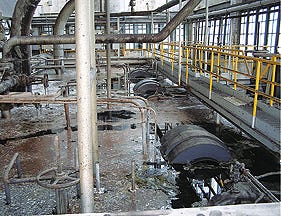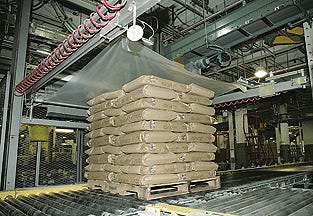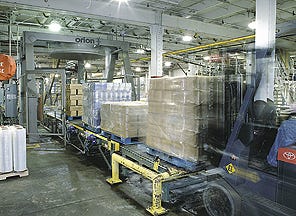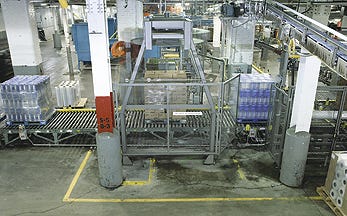Wrapping pallets after Hurricane Katrina
March 11, 2015

The company was able to add sophisticated, new end-of-line pallet-loading and stretch-wrapping equipment, which helped the plant recover and break earlier records.
It's not easy to see a silver lining in the clouds of a massive, destructive storm like Hurricane Katrina. Just ask those at the at the 100-year-old Chalmette refinery, which is owned by American Sugar Refining, Inc., maker of Domino Sugar. The devastating hurricane in August 2005 wrought havoc at the facility in Arabi, LA, only five miles south of New Orleans. But Chalmette, considered the largest sugar refinery in the western hemisphere, has resurged in a long, painful and incredibly difficult recovery, to say the very least, with nothing sugar-coated about it.
Named after the nearby Chalmette battlefield where General Andrew Jackson defeated the British in the war of 1812, the refinery warred with Hurricane Katrina and suffered a laborious aftermath. Miraculously, its recovery plan gave it the opportunity to actually modernize the multi-story facility and packaging operation with surprising results.
Visit www.packagingdigest.com/ info/domino to view an in-plant PALLET-WRAPPING ACTION VIDEO of American Sugar Refining's end-of-line wrapping and top-sheet-dispensing equipment described in this article.
The reopening was seen as key to maintaining stability for the long haul, because Chalmette produces a whopping 6.3 million lb of sugar daily. A fixture of the New Orleans community since 1909, the facility is said to refine more than half of Louisiana's cane crop and 100 percent of the Texas sugar crop. It is also claimed to produce about 950,000 tons of finished sugar per year.
Some said it would need a year to fully recover; others doubted that the refinery would ever operate again. The history-making storm had shattered 1,000 windows at the site, ruined seven roofs and damaged 195 railcars, 125 electrical motors and 12 motor-control centers. Miles and miles of wiring had to be replaced. And perhaps the most bitter statistic is that American Sugar Refining lost an astounding 28.5 million lb of refined sugar product and 20 million lb of raw sugar product, which was all swallowed by water.

Viewing the damage, many doubted that the 100-year-old Chalmette sugar refinery would ever recover.
The first responders to the refinery site in Katrina's wake found a lake of 150,000 gal of dissolved sugar in the company's storage sheds. Up to 5 ft of water had flooded the first floor of many of the buildings in the production complex, including the main refinery building, where the end-of-line palletizing and stretch-wrapping equipment was situated, along with bag-filling operations for commercial-sized (20-, 50- and 100-lb) sack quantities of sugar. Water ruined numerous electrical motors, controls and communication links and severely damaged the mechanical capability of all of the equipment. To repair the damage required an investment of approximately $65 million. Hundreds of employees and their families were also displaced—a seemingly hopeless situation.
But rather than downsize or close the facility, the company's managers decided to rebuild—a sweet decision they won't soon forget. Amazingly, the Arabi facility reopened and resumed sugar refining on Dec. 5, 2005—only 98 days after the hurricane. New equipment installations began after the flooded-out areas were refurbished and repaired. This not only helped to give hundreds of New Orleans workers an early holiday gift of going back to work, but it also gave millions of American grocery shoppers the packaged sugar they needed.
The company was able to add sophisticated, new, end-of-line pallet-loading and stretch-wrapping equipment from Orion Packaging Systems (www.orionpackaging.com) to the sugar-packaging operation. The installation has helped it to recover as well as break all of its previous output records and increase uptime and reliability, the plant states. Orion Packaging's distributor, Associated Packaging (www.associatedpackaging.com), played a key role in the success of the project and the wrapper installations.
There are also four robotic palletizing cells incorporating robotic palletizers from Fanuc Robotics (www.fanucrobotics.com) that can unitize three different loads of the higher-volume retail-sized packages at a time. There are also five new palletizers from Lambert (www.lambertpalletizers.com) that load bagged products on four-way and block pallets.

Pallets are automatically top-sheeted by a new dispenser before being shrink-wrapped to protect them from dust or contaminants.
The choice to upgrade right away has truly paid off, says plant manager Pete Maraia. "With the new equipment, and especially the higher-speed stretch wrappers, we can now pack as much product for shipment as we did before the storm—but do so in two shifts rather than three," he says. "We're definitely more efficient and productive today, and our energy costs are lower by about three percent. There was less training involved with this equipment, we're enjoying higher efficiencies, and there is less waste. And we like the fact that the service and parts are commercially available, which wasn't the case before." The company has been able to redistribute the idled, third packaging shift needed for training, service and additional recovery tasks throughout the refinery.
While a wide array of retail-sized sugar packages (in sizes up to 10 lb) is generated from the second floor, the first floor, which included multiwall bagging and palletizing of larger commercial and bulk-product quantities, was severely affected by Katrina. Much of the equipment on that floor was compromised by the flood waters, and the company says repairs would have taken much longer than upgrading with new systems, and probably would have been more expensive.
But almost all of the equipment brought in to rebuild the end-of-line sugar-packing operation represented an upgrade from what had been destroyed, which included 1970s- and 1980s-vintage equipment, Maraia explains. Thus, Hurricane Katrina had actually advanced a five-year plan of phased equipment upgrades. Before the storm, Domino had been planning to improve its end-of-line operation and packing equipment, but had trouble finding time to shut down to do it. Katrina changed everything. "We had a five-year plan to replace just about all of the systems," Maraia continues. "Katrina brought that planning to a head. Now, the refinery is more reliable and efficient than it was before the storm."

One of the three new, tower rotary stretch wrappers that carry out the main wrapping functions, above right, can wrap up to 120 loads/hr. The new systems complete in two shifts what formerly took three shifts.
In the meantime, an "interim" packing operation was established as a result of the storm that involved a period of hand bundling before the new equipment was installed in phases. The manual handling was also the result of the company's desire to meet customers' requirements with Domino products, it says. Hundreds of trailers were brought in to house employees and their families— and "Chateau Domino" was created. Before the new palletizers arrived, employees palletized the packaged product and wrapped the pallets by hand, determined to return the refinery to production.
Once locating all of Chalmette's employees was completed (many had been evacuated outside of the state), and they and their families were installed in trailers on the refinery's grounds, 12- to as many as 16-hr days became the norm as recovery began, following a task-by-task schedule.
As Maraia explains, there were great logistical challenges in getting the equipment installed and transported to the site because of the flooded-out conditions. "Just getting the workforce in, providing the people with food and housing and everything associated with that was an incredibly large task to achieve," he relates. "Much of the cleanup work was done at that time by hand, which involved lifting heavy, damaged equipment out of water, clearing up debris and removing damaged product. Once generators were running, and plant water was restored, things moved a bit more quickly."
Landline phone service wasn't completely re-established until nearly a year after the storm struck and as this writing, landline long-distance service is still not re-established in some areas. Cell phone service took up most of the burden, and a lot of communication continues to be done by cell phone and e-mail, PD is told.
Our communications were crippled, and we had very little electrical power to work with," relates Loretta DuBose, Associated Packaging's specialist serving the Chalmette account. "It was an incredible situation," she says. "We had been evacuated from the area and returned about two weeks after the storm, armed only with cell phones. It took about ten days to clean up the floodwaters. But phones or not, we found ways to communicate with the people at the plant."
But by Dec. 9, 2005, the Chalmette refinery resumed shipping and sent out its first railcar of product (see sidebar). The first of the new equipment was installed, and the plant generated 3 million lb of product a day. By March 2006, it was back up to production levels it enjoyed before the storm. "Since then, we have broken almost every record we set, pre-Katrina," Maraia points out.
Associated Packaging took the order for three Orion MA-33 automatic stretch-wrapping systems in November 2005, and the first machine shipped six weeks later on Dec. 28—four months after the hurricane struck—a quick turnaround for a large piece of equipment, especially considering the storm-ravaged region's environment, American Sugar Refining states.

A pallet load enters the work zone, above, and the wrapping cycle begins. The wrappers are on what American Sugar Refining calls a ‘main highway’ of travel in the plant.
The high-speed automatic MA-Series shrink wrappers have replaced older pallet-wrapping equipment that Maraia says had been operating at Chalmette for many years. The main wrapping functions are carried out by the three MA-33 automatic rotary tower wrappers that excel in the Orion line for speed, weight capacity and rugged endurance. The refinery needed the machines to wrap loads weighing up to 6,000 lb.
Equipment installations continued, and in early 2006, an Orion MA-55 rotary stretch wrapper, similar in design and performance to the MA-33, was also installed. Designed for wrapping lighter loads (up to 4,000 lb), the machine reaches speeds of 16 rpm. Two Orion HPA-66 automatic turntable stretch wrappers were then added to unitize specialty bag sizes and palletized, commercial-size bags of product that can weigh up to 5,000 lb.
Considered Orion's top-of-the-line system, the MA-33 automatic machine features a rotating wrapping arm capable of handling such loads at up to 30 rpm for a throughput of up to 120 loads/hr. While the robots have helped reduce manual labor, it is here, at the end of the line, that "productivity has significantly increased," Maraia points out.
On the MA-55, the pallets convey to the automatic wrappers, which unitize the loads securely for shipping. The rotary wrapper begins as the pallet is brought to its infeed conveyor. As the pallet is carried toward the stretch wrapper, a photoeye detects its presence, and its safety gates open. The pallet enters its work zone and the safety gates close as the wrapping cycle begins. During wrapping, the film is applied from the machine's Insta-Thread(TM) film carriage, which has been engineered to prestretch film at a standard fixed rate of 260 percent and deliver it to the load at a constant tension level. The MA-55 is able to wrap loads at speeds up to 70 loads/hr. The machine also comes with PLC controls and a film cutoff feature.
Mounted to the overhead rotary arm, the film carriage cycles four times on the top of the load and four times back down for eight revolutions, depending on the height of the load, finishing at its base, PD is told. After the wrap cycle is complete, the film tail is cut automatically with a hot knife that separates the film from the roll, and the load is then conveyed to an exit zone. With the rotary-arm wrappers, a finished, wrapped load can move out and an incoming load can start while the wrapping arm returns to its home position.
The HPA-66 wrappers are platform-automatic, which means they wrap the loads on a rotating platform and allow a forklift operator to place a load and start the wrap cycle without getting off of the forklift. A forklift driver deposits a pallet load onto the HPA-66 turntable, backs away and without having to take time to dismount, pulls a lanyard that begins the wrapping cycle. When the cycle ends, the HPA-66 clamps, cuts and attaches the stretch film, and the load is ready for pickup.
As the pallet loads convey to the pallet-wrapping stations, they're first top-sheeted on automatic Orion film-sheet dispensers to protect them from sugar dust before they're shrink-wrapped. Next, they're wrapped securely in the film wrap. "The equipment does a great job of flattening and squaring the loads prior to discharge," Maraia notes.
While refinery employees and their families are still recovering and restoring their homes, and the region's infrastructure moves along slowly and steadily, the huge plant by the river—an economic engine of the St. Bernard's Parish for almost 100 years—is up and running and, the company believes, is working better than ever.
More information is available:
Orion Packaging Systems, a div. of Pro Mach, Inc., 800/333-6556. www.orionpackaging.com.
Associated Packaging, Inc., 615/452-2131. www.associatedpackaging.com.
Fanuc Robotics America, Inc., 800/477-6268. www.fanucrobotics.com.
Lambert Material Handling, 315/471-5103. www.lambertpalletizers.com.
About the Author(s)
You May Also Like


